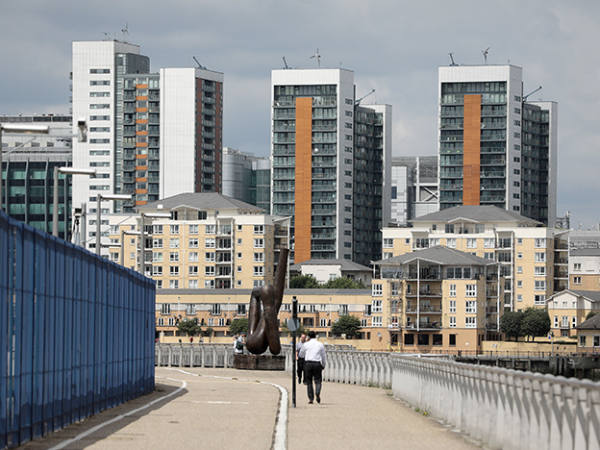Last month, a planning application was submitted for yet another skyscraper in Canary Wharf. This one, however, would be unique. Rather than your standard office block, Canary Wharf Group (CWG) and its development partner Kadans intend to spend £500mn creating “Europe’s largest and most technologically advanced life sciences building” in a 23- storey, 823,000 square foot tower.
The lab is being built speculatively, which means that the joint venture partners are building something for tenants which do not yet exist, and CWG and Kadans are far from the only ones bullish enough about the rewards on offer for lab space developers in the UK to take such risks.
At the end of 2021, Life Science Reit (LABS) listed on the London Stock Exchange after raising £350mn in an oversubscribed issue on the promise of delivering space for the UK’s life science and biotech industry. Meanwhile, real estate agency JLL (US:JLL) calculates that there is around £20bn worth of capital looking to invest in this nascent real estate sector. Much of this space will also be developed speculatively.
The collective hope is that the UK is on the verge of becoming a “scientific superpower”, as George Freeman, the UK’s minister for science, research and innovation, put it to the Financial Times last week. The idea has been bolstered by another statistic from JLL which calculates that there is around 2.76mn square feet of active demand for lab space from science and technology companies in the so-called ‘golden triangle’ of Oxford, Cambridge and London. On the supply side, JLL says there is practically zero space available.
In theory, that means there is enough unmet demand right now for CWG and Kadans to build two more similarly-sized lab towers. And that is ignoring the added demand that life science developers believe will emerge as the sector grows. It is an exciting prospect for a commercial real estate market in the midst of its worst downturn since 2008.
Yet, life science is not a guaranteed winner. The forthcoming recession, Brexit, a lack of government investment and a host of other challenges all pose problems. In short, there are doubts as to whether British science can breathe life into a flatlining real estate market.
A strong pulse
Joanne Henderson, EMEA head of life sciences at CBRE (US:CBRE), says 2021 was a "boom year" for life science real estate as the pandemic put the subsector in the spotlight. That boom has now passed, but she thinks this as a good thing on balance, describing what is left as a more stable, long-term interest from those who see the sector as resistant to recessions due to its revenue stream of tenants funded by research trials rather than the whims of the consumer economy.
Yet, as encouraging as that may sound to investors, Henderson says the subsector is not completely uncoupled from the current economic downturn. “Even the coolest biotechs on the planet are not immune to this because they’re venture capital funded,” she says.
There are other market realities which life science is not insulated from. Brexit is the chief among these. Pre-2016, the UK was part of a European science community called Horizon which shared a kitty of tens of billions of funding each year among EU nations. The EU also meant freedom of movement for the club’s best scientists, researchers and engineers. The UK has left that all behind.
“It’s certainly not a great thing to happen, but the impact of Brexit has so far has not been as severe as many people were predicting,” says James Shepherd, UK head of Kadans, the developer building the Canary Wharf lab tower with CWG.
For him, what has been more worrying in terms of government decision-making is its recent rhetoric on tougher immigration rules for international students. He and many others see the UK’s universities as the lifeblood of its life science industry with Oxford and Cambridge regularly topping tables as the two best in the world and Imperial College London often cracking into the top ten. Without top-class students, UK life science will lose its post-Brexit edge.
The government also runs the risk of damaging the life science sector by doing something much more benign: nothing. CBRE’s Henderson sees the lack of government investment in life science as a massive barrier to its own stated ambitions. She says that the US government has invested billions into its life science industry at both a national and local level over a long period of time whereas the UK has not.
The common refrain from the UK life science industry is that the current state of play, with world-class universities but government second-rate investment, means the UK is great for generating startups but bad for generating science or tech giants in the way the US does. This impacts real estate investment returns. Science tech startups can be okay tenants, but the real desire is for those companies to turn into homegrown, household names who are capable and eager to sign even bigger lab leases for more money.
Risk and reward
The need for public sector investment to boost UK life science will become especially important as the UK’s recession makes private sector investors more thrifty. The rising cost of debt, labour and construction is eating into the margins of all kinds of real estate developments at the moment, and for life science this is particularly problematic. Thinner margins make what is already a riskier investment compared with other real estate sectors riskier still. After all, cutting-edge lab space is, by its very nature, expensive to build.
And the upfront cost for the developer is not the only risk. The other is the covenant strength of the tenant. The groups who spin out of Oxbridge requiring world-class lab space may have come from multi-century old institutions, but they themselves will be young and inexperienced.
For a top of the range office building, a landlord would not dream of signing a lease with a one-year-old company with no balance sheet. For a lab space, however, that is par for the course. More than that, the one-year-old science company will generally be looking to take lab space for less time than a standard office tenant. An experiment or some research means the lab space might only be needed for a few years, compared with a law firm taking an office block in London for ten.
On top of all this, lab developers are often building space for imagined tenants. Speculative development is much more common in this sector than it is in offices, warehouses or retail because the life science industry is in its infancy.
“The life science sector is inherently risky and that risk needs to be priced in,” Kadans’ Shepherd says, adding that some investors raise their eyebrows about the idea of unknown tenants emerging to lease the completed labs. Even when said tenants do emerge, there is no guarantee who will thrive and who will not. “Some are good, some are less than good,” he concedes.
Yet, with this increased risk comes increased reward in the form of higher rents and higher building values. Shepherd hopes Canary Wharf will be a prime example of this. The area is not, he admits, an established life science location right now. But the developer’s hope is that by building an enormous lab tower there, it will be.
“How do we get scientists comfortable with the fact that they can do great science in Canary Wharf? Part of that is the building and part of that is the ecosystem we plan on generating over the next five years.”
And though each lab space is often seen as unique, Shepherd says that underneath the high-tech equipment laboratories can be quite similar. This means they can be reused by other scientists if a startup or young research body goes bust or runs out of funding.
That does not mean he believes that one-size-fits-all when it comes to life science real estate. Shepherd is strongly opposed to the term “lab-enabled office”, in which he believes some developers are trying to pull the wool over investors' eyes by converting what he sees as inappropriate spaces such as shopping centres or low-quality offices and labelling it life-science space. In his view, lab space needs to be tailor-made as lab space the practical parts of science – such as handling toxic chemicals or precious metals – to be done properly.
Life Science Reit sees things differently. The bulk of its work involves doing exactly what Shepherd is opposed to: turning office space in Oxford and Cambridge into lab space. Chief executive Simon Farnsworth says that this removes some of the risk involved in developing from scratch while still delivering high-quality laboratories. The proof of concept for its business model comes from its leasing activity. Though the Reit is converting much of this space speculatively, it has also signed many leases for space that it is still building out.
However, the Reit is not playing it completely safe. Farnsworth says that around 20 per cent of its portfolio is currently unlet. Though he says the company does not want its portfolio to be 100 per cent leased at any given time, to allow for some flexibility and churn for tenants to move in as others move out, he says he would like to see the portfolio get to 90 per cent let or higher.
To the long list of roadblocks stopping Life Science Reit or any other life science landlord getting to those levels of occupancy, there is one more: the possible post-pandemic obsolescence of offices. While a lot of science needs special laboratory tools and therefore cannot be done remotely, there is also a lot of science which can be.
Kadans’ Shepherd says that he has seen this impact on requirements for space in its developments. He estimates that where pre-pandemic science tenants would look for spaces that were 60 per cent standard desks and 40 per cent lab, they are now looking for the reverse post-pandemic. He says the result is a small drop in overall amount of physical space they need.
Even with all of these issues, the returns on a possible life science boom are already being realised. Some agents estimate that life science buildings can fetch up to 50 per cent more rent than an equivalent office building precisely because that high risk is factored into a laboratory’s valuation. As many real estate experiments in the past have shown, high risk can bring high rewards.













